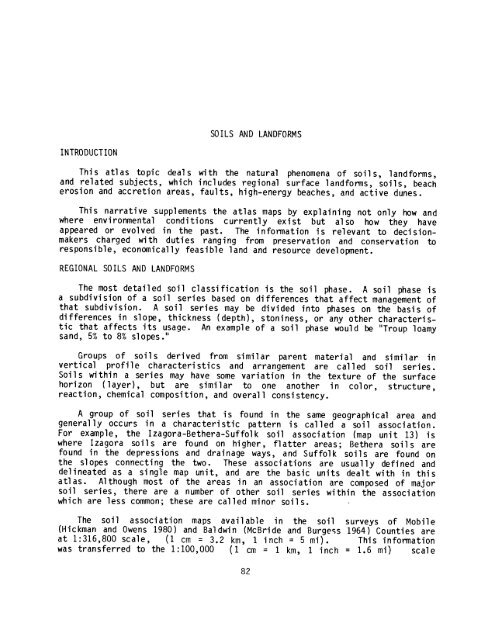ecological characterization atlas of coastal alabama - Data Center
ecological characterization atlas of coastal alabama - Data Center
ecological characterization atlas of coastal alabama - Data Center
You also want an ePaper? Increase the reach of your titles
YUMPU automatically turns print PDFs into web optimized ePapers that Google loves.
SOILS AND LANDFORMS<br />
INTRODUCTION<br />
This <strong>atlas</strong> topic deals with the natural phenomena <strong>of</strong> soils, landforms,<br />
and related subjects, which includes regional surface landforms, soils, beach<br />
erosion and accretion areas, faults, high-energy beaches, and active dunes .<br />
This narrative supplements the <strong>atlas</strong> maps by explaining not only how and<br />
where environmental conditions currently exist but also how they have<br />
appeared or evolved in the past . The information is relevant to decisionmakers<br />
charged with duties ranging from preservation and conservation to<br />
responsible, economically feasible land and resource development .<br />
REGIONAL SOILS AND LANDFORMS<br />
The most detailed soil classification is the soil phase . A soil phase is<br />
a subdivision <strong>of</strong> a soil series based on differences that affect management <strong>of</strong><br />
that subdivision . A soil series may be divided into phases on the basis <strong>of</strong><br />
differences in slope, thickness (depth), stoniness, or any other characteristic<br />
that affects its usage . An example <strong>of</strong> a soil phase would be "Troup loamy<br />
sand, 5% to 8% slopes ."<br />
Groups <strong>of</strong> soils derived from similar parent material and similar in<br />
vertical pr<strong>of</strong>ile characteristics and arrangement are called soil series .<br />
Soils within a series may have some variation in the texture <strong>of</strong> the surface<br />
horizon (layer), but are similar to one another in color, structure,<br />
reaction, chemical composition, and overall consistency .<br />
A group <strong>of</strong> soil series that is found in the same geographical area and<br />
generally occurs in a characteristic pattern is called a soil association .<br />
For example, the Izagora-Bethera-Suffolk soil association (map unit 13) is<br />
where Izagora soils are found on higher, flatter areas ; Bethera soils are<br />
found in the depressions and drainage ways, and Suffolk soils are found on<br />
the slopes connecting the two . These associations are usually defined and<br />
delineated as a single map unit, and are the basic units dealt with in this<br />
<strong>atlas</strong> . Although most <strong>of</strong> the areas in an association are composed <strong>of</strong> major<br />
soil series, there are a number <strong>of</strong> other soil series within the association<br />
which are less common ; these are called minor soils .<br />
The soil association maps available in the soil surveys <strong>of</strong> Mobile<br />
(Hickman and Owens 1980) and Baldwin (McBride and Burgess 1964) Counties are<br />
at 1 :316,800 scale, (1 cm = 3 .2 km, 1 inch = 5 mi) . This information<br />
was transferred to the 1 :100,000 (1 cm = 1 km, 1 inch = 1 .6 mi) scale<br />
82
















